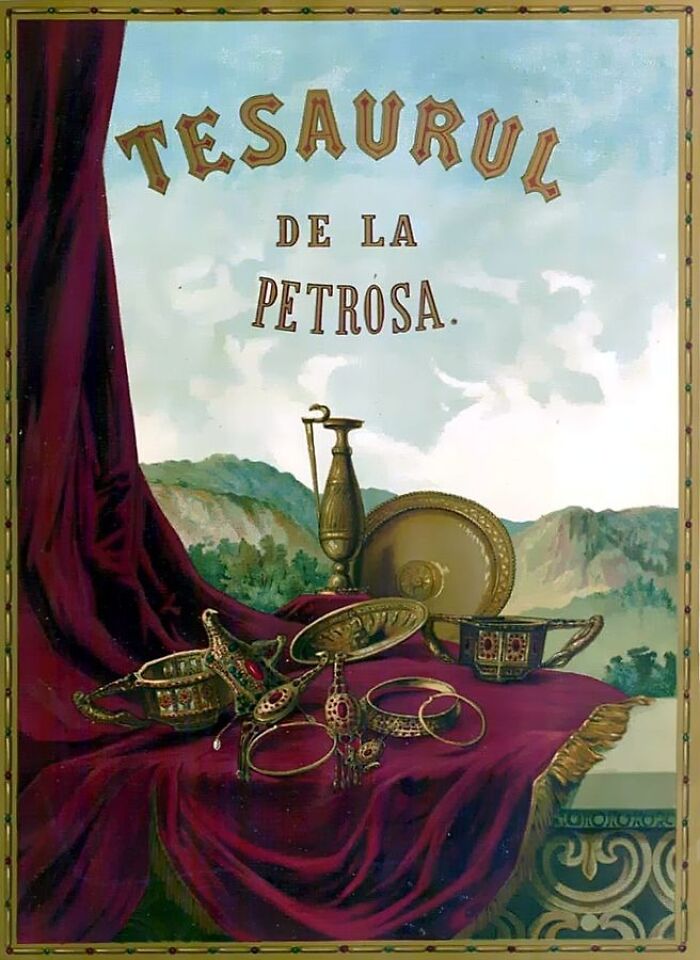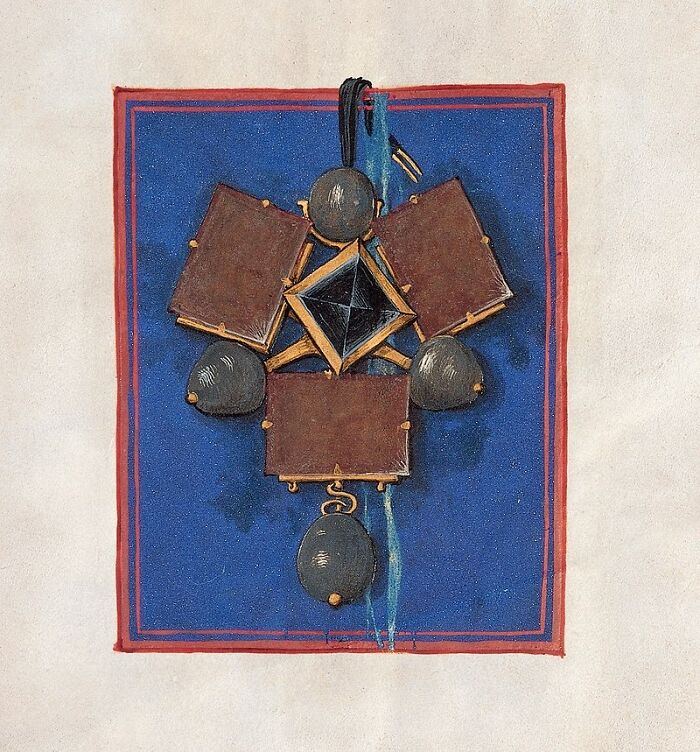
25 Treasures Buried Long Ago That Nobody Has Claimed Up To Now
It’s time to plan a heist, folks because apparently, there are many lost treasures out there just waiting to be found. So, don your thinking cap and put your detective skills to the test as you peruse this particular collection of missing treasure mysteries.
From Royal Caskets that were looted and never recovered to stolen pieces of jewellery, the lore abounds with hints and clues that may or may not lead to hidden valuables just waiting for an adventurous treasure hunter to discover them again.
#1 Royal Casket

Image source: wikipedia, Jannasch, Warsaw
The Royal Casket, created in 1800 by Izabela Czartoryska, contained 73 precious relics once belonging to Polish royalty. It was looted by the Wehrmacht during the German invasion of Poland in World War II and has never been recovered.
#2 Amber Room

Image source: wikipedia, igor-bon
The Amber Room, a stunning chamber decorated with amber panels, gold leaf, and mirrors, was originally constructed in the 18th century in Prussia. It was later moved to Russia but disappeared during WWII after being looted by German forces. Despite extensive efforts, it remains lost, though a reconstruction was completed in 2003.
#3 Peking Man

Image source: wikipedia, Yan Li
Peking Man, a subspecies of Homo erectus, was discovered near Beijing in 1921. Its fossils played a key role in anthropology and Chinese identity. However, during World War II, the fossils were lost, possibly when moved by the U.S. Marine Corps or aboard the Awa Maru, which sank in 1945.
#4 Patiala Necklace

Image source: wikipedia, National Portrait Gallery, London
The Patiala Necklace, created by Cartier in 1928 for Maharaja Bhupinder Singh, featured 2,930 diamonds, including the 428-carat “De Beers” diamond. It disappeared from the Royal Treasury of Patiala around 1948, with some diamonds later recovered.
#5 Lost Imperial Faberge Eggs

Image source: wikipedia, pre-Revolution 1917 photo catalog
Faberge eggs are jeweled creations by the House of Faberge, with 69 made during the Czarist era, though only 61 are known to exist today. Among them, 44 of the 50 Imperial Easter eggs are known to survive. Several, including the 1886 Hen with Sapphire Pendant and the 1909 Alexander III Commemorative Egg, are missing, their fates still unknown.
#6 Tucker’s Cross

Image source: wikipedia, Frederick Hamilton
Tucker’s Cross is a 22-karat gold cross adorned with seven emeralds, discovered by Bermudian explorer Teddy Tucker in 1955. It is believed to have originated from the Spanish galleon San Pedro, which sank in 1594. Initially thought to be Indian-made, the cross became the most valuable shipwreck artifact by 1997. Tucker sold it to Bermuda’s government in 1959 for display in the Aquarian Museum. However, it was stolen before a royal visit in 1966, replaced by a replica. Today, an escape room attraction in Bermuda’s Dockyard is named after the cross.
#7 Irish Crown Jewels

Image source: wikipedia, Dublin Police
The Jewels of the Order of St Patrick, also known as the Irish Crown Jewels, were a set of jeweled insignia created in 1831 for the Order of St Patrick. Stolen from Dublin Castle in 1907, the jewels and other items have never been recovered, and the theft remains unsolved.
#8 Drents Museum Heist Stolen Items

On January 25, 2025, thieves used explosives to steal priceless Dacian artifacts, including the Helmet of Cotofenesti, worth €4.3 million, from the Drents Museum in Assen, Netherlands. The items, on loan from Romania’s National History Museum, include gold bracelets and other Dacian treasures dating back to the 2nd century BC. The theft, which shocked both museums, has led Romania’s Ministry of Culture to vow to recover the artifacts.
#9 Florentine Diamond

Image source: wikipedia, Flint Institute of Arts
The Florentine Diamond, a 137.27-carat yellow diamond of Indian origin, was once part of the Austrian Crown Jewels. After World War I, Emperor Charles I took it into exile, where it was stolen and taken to South America. Rumors suggest it was later recut and sold in the 1920s.
#10 Romanian Treasure

Image source: wikipedia, Odobescu, Alexandru, Le Trésor de Petrossa, Paris, 1889-1900
The Romanian Treasure, a collection of gold (about 120 tonnes) and valuable items sent to Russia for safekeeping during World War I, was seized by the Soviet government after the 1917 revolution. Although some objects were returned in 1935, 1956, and 2008, none of the gold has been returned, making it a point of tension in Romanian-Russian relations.
#11 Honjo Masamune

Image source: wikipedia, Kakidai
The legendary samurai sword created by master swordsmith Goro Masamune, was a prized national treasure. Passed down through generations of shoguns, it was lost during the U.S. occupation of Japan after World War II.
#12 Three Brothers Jewel

Image source: wikipedia, Historisches Museum Basel, Peter Portner
Created in 1389, this jewelry piece featured three red spinels around a central diamond. Owned by notable figures like Duke John the Fearless and English monarchs, it was part of the Crown Jewels until 1644, after which it disappeared, possibly sold by Charles I’s wife.
#13 Sword Of Islam

Image source: wikipedia, Unknown author
A ceremonial sword, ordered by Mussolini in 1937 and crafted by Picchiani e Barlacchi, was presented to him by Berber collaborators in Italian Libya. It disappeared after July 1943, when Mussolini’s residence, Rocca delle Caminate, was destroyed and looted by the Italian Resistance.
#14 Nelson’s Chelengk

Image source: wikipedia, National Maritime Museum
The chelengk, a diamond-studded military decoration from the Ottoman Empire, was awarded to Admiral Horatio Nelson for his role in the Battle of the Nile. It was stolen from the National Maritime Museum in London in 1951, where it had been placed in 1929.
#15 The Gold Of The Rms Republic

Image source: wikipedia, White Star Line
The RMS Republic, a luxurious ocean liner from 1903, sank in 1909 after colliding with the SS Florida while carrying $3.25 million in gold. Known as the “Millionaires’ Ship,” it was the first major rescue aided by radio technology. Attempts to recover the treasure in 1919 failed.
#16 Brussels Airport Diamond Heist Stolen Items

Image source: wikipedia, Lucash
In 2003, robbers posing as police officers executed a swift heist at Brussels Airport, stealing $50 million worth of diamonds from a Swiss flight. Armed with assault rifles, they stopped the plane, seized 130 bags of gems, and quickly escaped. Though some diamonds were recovered, many remain missing. In 2013, several arrests were made after the thieves tried to sell the stolen diamonds. The trial continued for years, with the alleged mastermind eventually sentenced in 2019.
#17 Isabella Stewart Gardner Museum Stolen Artwork

In March 1990, two thieves disguised as police officers stole 13 valuable works of art from the Isabella Stewart Gardner Museum in Boston. The theft, valued at $500 million, remains unsolved, and no artwork has been recovered. The museum offers a $10 million reward for information.
#18 Lufthansa Heist Stolen Items

Image source: wikipedia, Julian Herzog
The Lufthansa heist, which took place at John F. Kennedy International Airport in December 1978, saw the theft of $5.875 million, including cash and jewelry. It was the largest cash robbery in U.S. history at the time. James Burke, connected to the Lucchese crime family, was suspected of masterminding the crime but was never charged. Several co-conspirators were allegedly murdered to keep the money. The stolen valuables were never recovered, and the case remains one of the longest investigations in U.S. history.
#19 Scepter Of Dagobert

Image source: wikipedia, Thomas Clouet
Part of the French Regalia since the 7th century, the treasure, named after King Dagobert I, was kept in the Basilica of Saint-Denis until it vanished in 1795, likely stolen. It was created by master goldsmith Saint Eligius.
#20 La Noche Triste Treasure

Image source: wikipedia, histogames
La Noche Triste was a significant event during the Spanish conquest of the Aztec Empire, where Hernán Cortés and his forces were forced to flee Tenochtitlan after looting a vast amount of gold from Moctezuma II’s palace, leaving the treasure lost to history.
#21 Hatton Garden Safe Deposit

Image source: wikipedia, RHaworth
In April 2015, a heist at a London safe deposit facility, valued at up to £14 million, was carried out by six elderly thieves. While £4.3 million was recovered, the rest remains missing. The thieves were arrested, convicted, and sentenced in 2016.
#22 The Just Judges

Image source: wikipedia, Jan van Eyck
The Just Judges, a panel from the Ghent Altarpiece by Jan and Hubert van Eyck, was stolen in 1934 and remains missing. The panel is believed to feature portraits of contemporary figures like Philip the Good and possibly the artists themselves.
#23 Great Bell Of Dhammazedi

Image source: wikipedia, Note’s Portfolio
Cast in 1484 by King Dhammazedi of Myanmar, the world’s largest bell hung at Shwedagon Pagoda until 1608, when it was stolen by Portuguese mercenary Philipe de Brito. On its journey to be melted down, the bell sank in the river, and despite numerous searches, its location remains unknown.
#24 Treasure Of Lima

Image source: wikipedia, willianjusten
The Treasure of Lima, looted from the Spanish in 1820, is a legendary hoard of gold, silver, and jewelry, believed to be buried on Costa Rica’s Cocos Island. Its value is estimated at £160 million ($208 million) today, but it remains lost.
#25 Menorah From The Second Temple

Image source: wikipedia, Jebulon
The menorah is a seven-branched candelabrum mentioned in the Hebrew Bible, historically used in the Tabernacle and the Jerusalem Temple. It has long symbolized the Jewish people and Judaism, both in Israel and the Diaspora. After the establishment of the State of Israel in 1948, the menorah became its official emblem. It is considered a missing treasure, with the original candelabrum lost to history after the destruction of the Second Temple.












Got wisdom to pour?